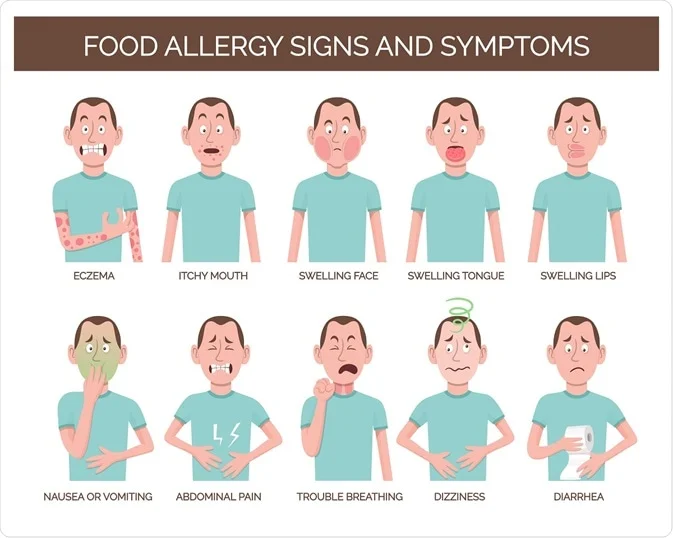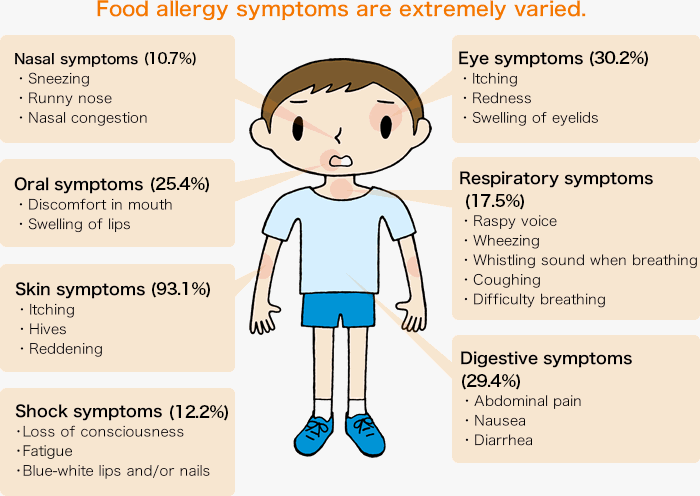Food allergy reactions can vary unpredictably from mild to severe. Symptoms of a food allergy reaction usually start seconds to minutes after your baby eats a food theyre allergic to.

A Natural Approach To Addressing Food Allergies Bicomuk
It can involve the lungs skin mouth heart eyes brain and gut area.

What is a mild food allergy. Food allergy on the other hand is more often associated with stomach or bowel problems and may cause hives. However antihistamines cant treat a severe allergic reaction. These drugs can be taken after exposure to an allergy-causing food to help relieve itching or hives.
This is why allergists do not like to classify someone as mildly or severely food allergic. A food allergy occurs when the immune system reacts to a harmless food. Food allergy is an immune system reaction that occurs soon after eating a certain food.
All allergy-inducing ingredients must be listed on food labels. Symptoms of a food allergy can affect different areas of the body at the same time. Some people with hay fever will experience mild food allergy symptoms an itchy mouth for example when eating certain fruits and vegetables that are related to.
Symptoms caused by a food allergy can range from mild to life-threatening. Allergies to shellfish like oysters are common. A mild allergic reaction is an allergic reaction that isnt life threatening but can still cause moderate discomfort to sufferers.
Food intolerance occurs when the body has a chemical reaction to eating a particular food or drink. The severity of each reaction is unpredictable. While nine foods milk egg peanut tree nuts soy wheat fish shellfish and sesame account for the vast majority of food allergies virtually any food can cause an allergic reaction.
Swelling of the face lips and eyes. Its caused by your immune system wrongly recognizing some. IgE-mediated food allergy The type of allergy most commonly seen in infants and children are milk tree peanuts eggs soy wheat and nuts.
Mild food allergy reactions may involve only a few hives or minor abdominal pain though some food allergy reactions progress to severe anaphylaxis with low blood pressure and loss of consciousness. An itchy sensation inside the mouth throat or ears. Some common symptoms include.
For a severe allergic reaction you may need an emergency injection of. Learn how to distinguish mild and severe food allergy reactions and always treat severe reactions with epinephrine. It is caused when the body mistakes an ingredient in food usually a protein as harmful and creates a defense system antibodies to fight it.
Allergic reactions can involve several parts of the body at the same time. Even a tiny amount of the allergy-causing food can trigger signs and symptoms such as digestive problems hives or swollen airways. This allergic reaction occurs because the immune system recognizes harmless proteins in the food as dangerous and triggers an allergic reaction to expel them.
Symptoms can affect different parts of the body can occur alone or in combination and can range from mild to. Although allergic reactions are often mild they can be very serious. Food allergy affects an estimated 6 to 8 percent of.
What is a Mild Food Allergy. This will often lead to unpleasant symptoms commonly including itching or swelling of the mouth a raised rash and vomiting. People who have previously experienced only mild symptoms may suddenly experience a life-threatening reaction called anaphylaxis which can among other things impair breathing and cause a sudden drop in blood pressure.
The symptoms of allergic reactions range from mild to severe to life threatening. For a minor allergic reaction over-the-counter or prescribed antihistamines may help reduce symptoms. The symptoms for mild to moderate food allergy or intolerance may sometimes be similar but food intolerance does not involve the immune system and does not cause severe allergic reactions anaphylaxis.
The American College of Allergy Asthma Immunology say that the most common food allergens for children are milk eggs and peanuts. A food allergy is when the bodys immune system reacts unusually to specific foods. While a severe allergic reaction can cause the throat to swell shut compromising breathing a mild allergic reaction usually just results in itching redness and irritation.
And even a very small amount of the problem food is enough to cause a reaction. A food allergy is a medical condition that happens when exposure to certain foods triggers a harmful immune response. Learn how to tell the difference between a food allergy reaction and eczema here.
A food allergy is a condition in which certain foods trigger an abnormal immune response. Other signs of a mild to moderate food allergy reaction include. Food allergies are very common with 15 million people in the USA alone estimated to be affected by a food allergy of some kind.
A food allergy develops if the bodys immune system produces an abnormal response to one or more proteins contained in food. The most common food allergies are shellfish nuts fish eggs peanuts and milk. What is a food allergy.
The first symptoms of an allergic reaction usually appear between a few minutes and two hours after exposure to a food. In some people a food allergy can cause severe symptoms or even a life-threatening reaction known as anaphylaxis. An allergic reaction occurs when the antibodies are battling an invading food protein.
A food allergy is an immune system response.

Iso 22000 Resource Center Food Allergen Management
Signs You Might Have A Food Allergy Integris Health

Food Allergy Or Intolerance Unilever Food Solutions Ca

Iso 22000 Resource Center Food Allergen Management

Food Allergy Symptoms Weaning Advice On Allergies When Weaning

Food Allergies Sensitivities Intolerances Pleij Salon Spa

Food Allergies Explained Symptoms Causes Diagnosis Ige And More

Food Allergy The Basics Tokyo Allergy Information Website

Food Allergy Symptoms Weaning Advice On Allergies When Weaning
